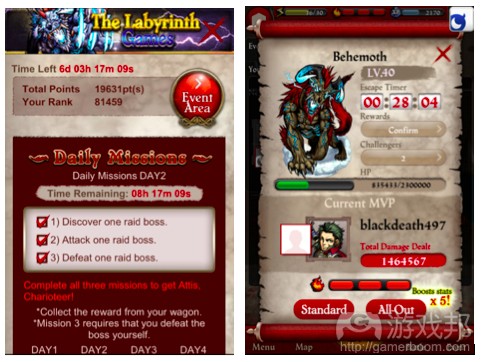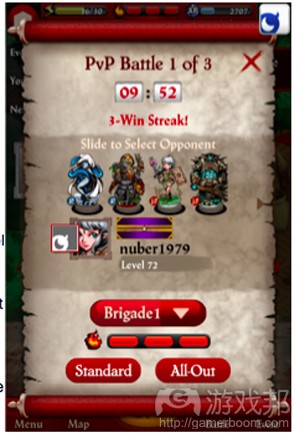解析《Blood Brothers》游戏设计的诀窍
作者:Kevin Oke
DeNA旗下平台Mobage游戏《Blood Brothers》已登陆iOS和Android一周年,该游戏盈利性仍然十分可观,自上线以来每月ARPU一直有所增长。现在是时候深入探讨这款收集卡牌游戏(以下简称CCG)获得成功的秘诀了。
虽然这款游戏深深扎根于CCG题材的惯例(“无需动手”的战斗,卡牌融合,gacha机制),但也添加了其本身的创新特点。
PvP玩法
《Blood Brothers》在多个关卡中的PvP设置表现出众,其中之一就是令机制浅显易懂,确保玩家清楚游戏的用户获取、粘性和盈利功能,以及他们使用这些功能可得到的好处,此外还通过巧妙的定时和提供奖励促使玩家采取这些行动。这主要是通过情境对话框和限时推广信息来实现。
PvP玩法通常是一种强大的留存率和盈利性来源,因此尤其需要令机制浅显易懂。《Blood Brothers》会在玩家闯关过程中,随机发起PvP战斗,令玩家牢记PvP元素。这些随机战斗的有效性表现在以下几个方面:
*呈现PvP玩法令玩家对其产生兴趣,并强化游戏留存玩家以及盈利的能力。
*增加PvP的效力以抵消斗志低落的情况(游戏邦注:斗志是玩家参与PvP和boss空袭战的一种可填充能量资源)
*清晰、简单的目标和激励(玩家连胜数场可以赢得道具)——这些可以吸引玩家,延伸他们在游戏中的会话时间,在玩家试图连胜的过程中排遣他们的斗志。
虽然这些并非《Blood Brothers》独有的概念,但其植入的“全力攻击”(比常规攻击更有效力,但会多耗损3倍的士气)以及高级的boss突袭战进一步令斗志成为一种宝贵资源,也让玩家更易于采取微交易行为。
最后,与《Rage of Bahamut》PvP战斗中混乱而复杂的用户体验相比,《Blood Brothers》中的障碍更少。玩家进行了预先选择后,就不需要再使用筛选对手的选项,系统还会向玩家清楚呈现每一种选择的风险和奖励,以及玩家牌组如何与其潜在对手一决高下等情况。
多种活动
持续提供限时活动正是一款成功CCG的生命之源,《Blood Brothers》对此也不例外。但多样性的竞争和合作事件,正是它脱颖而出的优势之一。基于团队的“拉踞战”,保持实时更新战绩的活动尤其令人兴奋。
其真正的高明的地方在于,以动态更新战绩和进程(绝佳的紧张感来源)的方式推出限时活动,并为这些活动采用了快速中止的计时器。这些计时器根据能量和斗志填充时间进行了调整,确保玩家到达排名和奖励的最高层时,必须花钱才能维持能量和斗志加满的情况。这是一种十分良好的盈利结构设计,因为紧迫感和风险正是令玩家转化为付费用户的一种极大的压力来源。
有趣的决定
《Rage of Bahamut》由于缺乏玩家主导权或有趣的决定而招致一些诟病,而《Blood Brothers》却能够保持非常紧凑的强制循环,并通过技术转移,关卡中的分支路径,以及不同技能团队的阵营而发挥创新。
用户留存
Mobage在日常登录奖励上也不走寻常路,会在新玩家第10天、20天、30天(非连续)登陆游戏后对其提供一次性的高级卡牌奖励。这是一项明智举措,因为《Blood Brothers》吸引的是那些成天离不开智能手机,并且对“硬核”而非“休闲”游戏更感兴趣的年轻用户群体。
其他盈利机会
奇怪的是Mobage似乎还没有充分利用一些盈利渠道:
*重新投机卡牌——玩家可以赢取那些可用于卡牌的状态提升水晶,允许玩家重新取回已经投入卡牌的任何升级水晶。
*即时进化卡牌——为了实现游戏平衡,此项功能可能要设置极高定价,并令游戏中最强大级别的卡牌失效。
总结
这款游戏相对线性的玩法或许无法征服所有硬核玩家,但它确实推进了CCG题材的发展,并展现了此类游戏在玩法深度上的潜力。随着CCG的成熟,人们对更复杂的移动社交游戏兴趣的增长,我相信这种融合趋势将迎来一些更具创新和趣味性的作品。(本文为游戏邦/gamerboom.com编译,拒绝任何不保留版权的转载,如需转载请联系:游戏邦)
Guest Post: The secrets to Blood Brothers’ success
Kevin Oke
Editor’s note: DeNA’s Japanese RPG card battler has been a hit for the mobile-social gaming juggernaut since release. As Inside Mobile Apps previously reported, Blood Brothers’ events feature is wildly successful for the game. In a third guest post from Kevin Oke, lead designer at both Adrian Crook & Associates, a social-mobile game design consultancy, and PlayRank, a second screen startup, he analyzes the successful components of Blood Brothers from an outsider’s perspective. He previously wrote guest posts for Inside Mobile Apps which analyzed Supercell’s Clash of Clans and NimbeBit’s Nimbe Quest.
DeNA Mobage’s Blood Brothers for iOS and Android recently celebrated its one year anniversary, and is continuing to monetize very well, with an ARPU that has grown every month since release. With this milestone in mind, now seems like a good time to take a dive into the game and highlight some of the things this collectible card game (CCG) does well.
Although it’s certainly firmly rooted in the conventions of the CCG genre (“hands-off” battles, card fusion, gacha) Blood Brothers does add its own touches of innovation, as explained below.
Blood Brothers PvP battle surfacingPvP
Blood Brothers excels at player vs. player (PvP) on a number of levels, one being surfacing. Good surfacing ensures that players are not only made aware of key AEM (Acquisition, Engagement, Monetization) features and the benefits they stand to gain by using them, but also pushed towards these behaviors via smart timing and offering incentives. This is generally done through contextual dialog boxes and limited time promotions.
As PvP gameplay is traditionally a strong source of retention and monetization, it’s especially important to do surfacing well. Blood Brothers keeps PvP at the forefront of the player’s mind with random PvP battles while the player is progressing through a level. These random battles are effective in several ways:
Surfacing of PvP gameplay to get the player interested in it and strengthen its ability to help monetize and retain players.
Increases PvP’s effectiveness as a morale sink (morale being the rechargeable energy resource needed to engage in PvP and raid boss fights).
Clear, simple goals and incentives (winning streaks reward the player with items) — these suck the player in, extending sessions and draining the player of their morale as they attempt to extend their win streak to hit the next reward.
Although conceptually not unique to Blood Brothers, the inclusion of “all-out attacks” (more effective than regular attacks but three-times more costly in terms of morale) and high level raid bosses that are susceptible to them further help to keep morale a precious resource and make a micro-transaction refill more tempting.
Lastly, compared to the confusing and convoluted user experience (UX) that precludes getting into a PvP match in Rage of Bahamut, there is little such friction in Blood Brothers. Opponent selection filtering options are eliminated in favor of pre-determined choices, and it’s immediately clear to the player what’s at stake with rewards, and how their deck stacks up against their potential opponents.
Variety of Events
A steady supply of time-limited events is the lifeblood of a successful CCG, and Blood Brothers is no different in this regard. However the variety helps to set the game apart, with competitive and cooperative events. Team-based “tug of war” style events where standings update in real-time for control of fortresses are particularly exciting.
The real genius at play here is the use of time-limited events with dynamically updated standings and progress (a great source of tension), and short expiration timers for said events. These timers are tuned with the recharge time lengths for energy and morale in mind. This ensures that in order for the player to reach the upper echelon of rankings and rewards, they must spend money in order to keep their energy and morale topped up. This is a very well constructed monetization pinch, as the urgency and stakes at hand are a great source of pressure and tension for conversion to paid.
Blood Brothers montization pinch used in events exampleBlood Brothers limited-time events screenshots
Blood Brothers new user daily login bonusInteresting Decisions
CCGs in the mold of Rage of Bahamut have received some criticism for a lack of player agency or interesting decisions. Blood Brothers does innovate while maintaining a very tight compulsion loop, with skill transferring, branching paths in levels, and different party formations with skills that leverage these formations.
Pushing the Envelope on Retention
Mobage chose to push the envelope on daily login bonuses, as new users can earn one-time rewards of high grade cards after 10, 20, and 30 days (not consecutive) of logging in. This is smart as Blood Brothers appeals to a youthful audience that live on their smartphone and skew more towards “core” than “casual” in terms of gaming habits and tastes.
Additional Opportunities for Monetization
Strangely there are a few opportunities for monetization that haven’t been touched on yet by Mobage:
Re-specing cards — The player can earn stat boosting crystals that they can bestow upon the card of their choice. Allow the player to gain back any upgrade crystals they’ve sunk into a card.
Instantly evolve a card — skipping the need to hunt down a duplicate for the evolution to take place. For balancing purposes, this would need to be priced very high, and disabled for Legendary grade cards (the best in the game).
Conclusion
It may not win any core gamers over with its relatively linear gameplay, but Blood Brothers advances the CCG genre and points toward the potential for greater gameplay depth within it. As CCGs mature and the appetite for more complex social games on mobile grows, I expect this convergence will unlock that potential, yielding some innovative and fun results.(source:insidemobileapps)










































 闽公网安备35020302001549号
闽公网安备35020302001549号